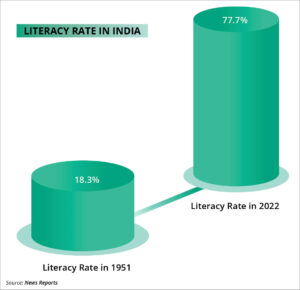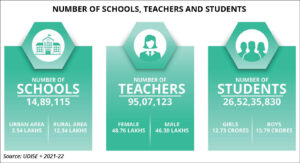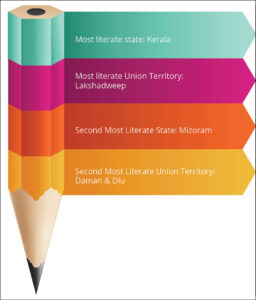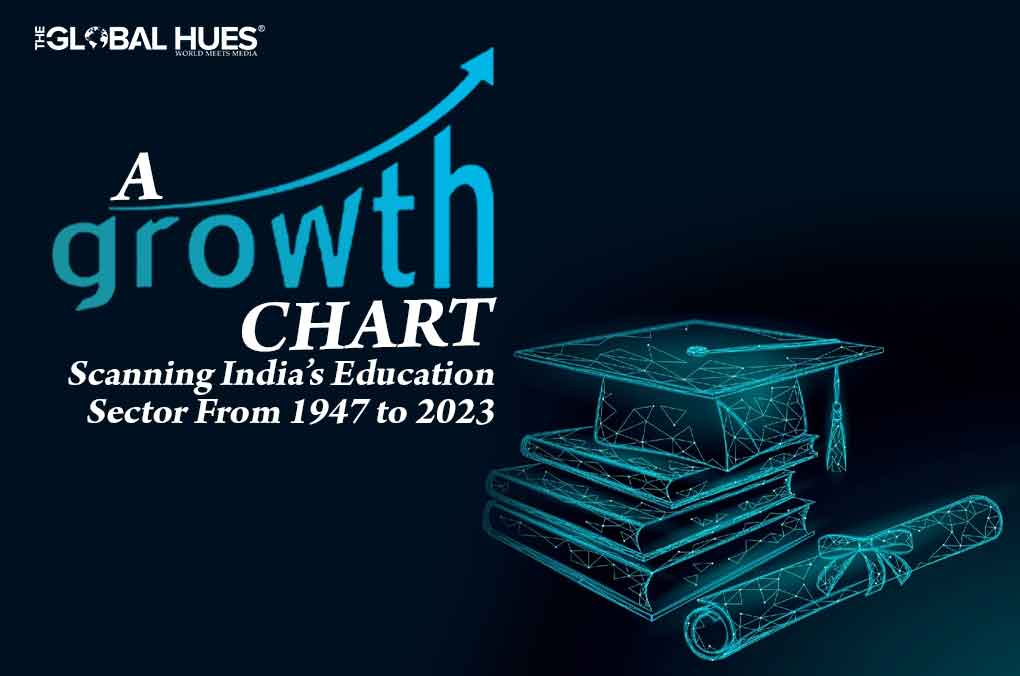It goes without saying that education is the passport to the future. Tomorrow belongs to those who prepare for it today.
A young independent India that freed itself from the clutches of British rule in 1947 had to pull up its socks to make itself more educated. And that’s exactly what the country did.
To come up with flying colours in the field of education was bound to take a long time. Despite facing tornadoes on the way, India succeeded in establishing itself amongst the largest education systems.
India’s education sector has progressed at a breakneck speed, with an extensive network of more than 1.4 million schools. A lot of educational reforms by the government coupled with utilising untapped resources, primarily technology, have paved the way for an educated India.
Let’s get to the bottom of how India has become a powerhouse of learning.
LITERACY RATE
| The literacy rate is defined by the percentage of the population of a given age group that can read and write. The adult literacy rate corresponds to ages 15 and above, the youth literacy rate to ages 15 to 24, and the elderly to ages 65 and above.
Source: UNESCO |
When India became independent, the Literacy rate in India was only 12 per cent but it has increased to a whopping 77.7 per cent. The country is now focusing on reducing the gap in literacy rates between girls and boys. It has gradually narrowed over the years as various girl education initiatives have been implemented.
At the time of independence, the school dropout rate was quite high but it has currently reduced to 12.6 per cent. Female students face significantly higher dropout rates as compared to male students. The reasons for the dropouts are the prevalence of early marriage and education not being considered a priority for girls.
The literacy rate in urban areas is higher as compared to rural areas. It stands at 84.11 per cent in urban India while in rural areas, it is 67.77 per cent.
Various government schemes like Sarva Shiksha Abhiyan (SSA), National Programme for Education of Girls at Elementary Level (NPEGEL), Mid Day Meal Scheme (MDMS), Mahila Samakhya, Rashtriya Madhyamik Shiksha Abhiyan (RMSA), Samagra Shiksha Scheme and more policies and schemes are ensuring increased access to better and good quality education.

-
Enrolment Ratio
Enrolment Ratio:Total enrolment in a specific level of education, regardless of age, expressed as a percentage of the eligible official school-age population corresponding to the same level of education in a given school year. Source: UNESCO |
Gross Enrolment Ratio:Total enrolment in a particular level of school education, regardless of age, expressed as a percentage of the Population of the official age group which corresponds to the given level of school education in a given school year. Source: UDISE+ |
Net Enrolment Ratio:The total number of pupils enrolled in a particular level of school education who are of the corresponding official age group expressed as a percentage of the population of the official age group that corresponds to the given level of school education in a given school year. Source: UDISE+ |
India’s Gross Enrolment Ratio (GER) at primary, upper primary, secondary and higher secondary has improved in 2021-2022 as compared to last year. There has been a notable improvement in GER of higher secondary as the number has increased from 53.8 per cent to 57.6 per cent in 2021-22.
In 2021-22, the total number of students enrolled in school education from primary to secondary education stood at 25.57 crores, a whopping increase of 19.36 lakh enrolments as compared to 2020-21.
Over 12.29 crore girls enroled in the primary to higher secondary schools in 2021-22, showing an increase of 8.19 lakh enrolments as compared to 2020-21. The enrolment of Children with Special Needs also showed an increase of 3.45 per cent.
-
Number of Schools, teachers and students

- Schools: Over the course of 7 decades of independence, the schools in India have progressed at a staggering rate. The total number of schools in 2021-22 stood at 14.89 lakhs. The number of colleges has increased from 578 colleges in 1950-51 to 42,343 colleges currently. There were only 27 universities in India in the early 1950s but the number has surged to 1,043.
- Teachers: Teachers are the ones who change lives, inspire dreams and are key in ensuring that students get quality education. The total number of teachers has increased from 5.38 lakhs in 1950-51 to 95 lakhs in 2021-22. The salary and working conditions of teachers have also improved.
- Students: The number of students enrolled for education has increased tremendously over the year. Between 2001 to 2011, the student population in India exploded from about 229 million students to 315 million, a growth of nearly 38 per cent. The number stood at 26,52,35,830 between 2021-22.
According to the UDISE+ report, 98.22 per cent of schools have safe drinking water, 89.34 per cent of schools are equipped with electricity connections, and 87.30 per cent of schools have libraries.
Principal
|
Principal
|
HOW NGOS ARE STRENGTHENING EDUCATION
Non-governmental Organisations (NGOs) play a critical role in supplementing, complementing or substituting the formal education system and reaching out to the underprivileged, challenged, and excluded sections of society. NGOs not only develop learning skills in local communities but also work as a catalyst in bringing an overall sustainable change in children’s lives.
Despite the government playing a pivotal role in education, children in remote areas and urban slums do not get access to education. By providing quality education to such children, NGOs are working as alternative agencies and promoting awareness to bring change and holistic improvement in society. NGOs work at the grassroots of society to primarily achieve the impact on the ground.
Hundreds and thousands of NGOs in India are changing the lives of children for the better. They are contributing their fair share in improving education, reducing poverty, promoting social welfare and developing civil society.
Founder
|
Founder
|
Principal
|
Founder
|
Founder
|
GROWTH OF THE ED-TECH SECTOR
When the pandemic hit the nation, the need for a hybrid model of education led to the expansion of the edtech industry. Ed-tech companies came into the limelight because of their indispensable role in transforming the consumption of education. The increased adoption of educational technology led to higher revenue and growth for edtech companies.
According to reports, India is the second largest market for e-learning after the United States with a market size of $6 billion and is expected to grow to around $10 billion by 2025 due to several factors like an increase in online content consumption, high penetration of the internet and smart devices, and the demand for skilled professionals in the workforce.
-
Increasing Online Content Consumption
Most edtech startups today make products in video formats since learners now prefer to consume content via videos. As the demand for video content is continuously increasing, this will lead to the growth of the edtech industry.
-
High Internet Penetration
India has around 622 million active internet users and the number will surpass 900 million by 2025 due to the increased usage of smartphones and tablets. The consistent growth in the number of internet users in the country will contribute to the expansion of the edtech industry.
-
Increased demand for young skilled professionals
Companies nowadays demand specific skill sets as machine learning, blockchain technology, and artificial intelligence are gaining popularity. To upskill their skillset, graduates and professionals are unlocking the potential of online learning platforms. In the future, demand for upskilling and reskilling will pave the way for the success of the sector.
Its Contribution In The Education Sector
Since its evolution, the EdTech industry has provided innovative solutions to address the challenges faced by the education sector. Education has become more accessible because of the integration of technology.
- EdTech has enabled learners to educate themselves flexibly from the comfort of their homes and study at their convenience.
- EdTech has made it convenient and easy for learners to join online classes through smartphones.
- Learners are able to get a personalised learning experience, depending on their own pace of learning.
- As the online courses are available in vernacular languages, learners can learn in their own language, thus helping them understand better.
- The burden on teachers has also been reduced due to the simplification of data management. Teachers can now focus on what actually matters. As teachers get real-time data on their student progress, they can support students as per their needs.
- EdTech has enabled creativity, critical thinking and collaboration. Educators are able to create a learning space where the students feel safe and inspired.
President & CEO
|
Founder & Trainer
|

BUDGET 2023: HIGHEST-EVER ALLOCATION TO EDUCATION
Years |
Budget Allocated on Education (Rs Crore) |
2017-18 |
81, 868 |
2018-19 |
85,010 |
2019-20 |
94,854 |
2020-21 |
99,312 |
2021-22 |
93,224 |
2022-23 |
1,04,278 |
2023-24 |
1,12,900 |
The Union Budget presented by the Finance Minister of India in February 2023 put much-needed emphasis on the country’s education sector owing to the loss it has incurred due to the Covid-19 pandemic. The sector has received its highest-ever allocation of INR 1.12 lakh crore ($ 13.66 Bn).
Nirmala Sitharaman acknowledged the need for advanced teacher training and building resilient mechanisms in education delivery. The government will emphasise innovative pedagogy, dipstick surveys, continuous professional development, curriculum transaction, and ICT implementation to re-envision teachers.
The Finance Minister also talked about the need for a National Digital Library for children and adolescents. She said, “The national digital library for children and adolescents will be set up for facilitating (the) availability of quality books across geographies, languages, genres, and levels.”
The budget also talked about the recruitment of 38,800 teachers and support staff for the 740 Eklavya Model Residential Schools (over the next three years) which would serve 3.5 lakh tribal students in the country.
While lauding the Budget, Union education minister Dharmendra Pradhan said “By giving a boost to education, skill development, entrepreneurship, research and development, digital infrastructure, green growth and job creation, the Budget draws a meticulous blueprint for India at 100 and lays a solid foundation for transforming India into a technology-driven knowledge-based economy.”
-
Make AI in India
In 2018, NITI Ayog proposed the setting up of Centers of Excellence (CoEs) for AI learning and development. It’s time for our nation to start focusing on Artificial intelligence considering the popularity that ChatGPT and other AI tools are earning in the market. While presenting the budget, Nirmala Sitharaman suggested a vision for ‘Make AI in India’ and ‘Make AI Work for India’. To make this vision a reality, the government will set up three Artificial Intelligence Centres of Excellence (CoE) in top educational institutions.
THE BOTTOM LINE
No sector stayed untouched by the impact of Covid-19. Education too was put on hold but despite taking a hit, the Indian education system managed to provide the best education it can. E-learning and online schooling played an outstanding role here. Although the education level has increased, a lot still needs to be done.
The future of education will be bright and promising if we make informed policy choices, critically evaluate and learn from the present and the past, and actively invest in the larger purpose and vision.




